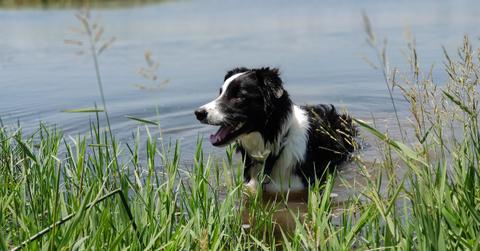Why Toxic Blue-Green Algae Blooms Have Killed 4 Dogs This Week
Updated Aug. 12 2019, 3:20 p.m. ET

The U.S. EPA is advising dog parents to keep their pets out of algae-covered ponds and lakes at the moment, due to risk of death via toxic blue-green algae. Four dogs have already passed away in the past week after playing in the water and ingesting the algae, which causes seizures and liver damage. Here's everything you need to know about the blue-green algae bloom, how to avoid it, how to treat a possible poisoning, and more.
On Thursday, Aug. 8, Melissa Martin and Denise Mintz took their dogs to a pond in Wilmington, N.C. — and 15 minutes after leaving, their dog Abby had a seizure, CNN reported. The dogs were all rushed to the hospital, and pretty soon, the other two dogs, Izzy and Harpo (who was Martin's therapy dog) were also having seizures. All three dogs started experiencing liver failure, and within a few hours, the vet had to put them each down. Martin's veterinarian said that the blue-green algae was the cause of death, as per CNN.
"What started out as a fun night for them has ended in the biggest loss of our lives. We need your prayers. Not sure we’re strong enough to get through this without them," Martin wrote in a Facebook post.
And on Saturday, Aug. 10, a couple took their border collie Arya to play in the water at Lake Allatoona in Georgia, local Atlanta news outlet 11Alive reported. About 30 minutes after leaving the lake, Arya started making "weird" noises and vomiting in the car, pet parent Morgan Fleming wrote on Facebook, as per 11Alive. The couple drover her to the emergency room, and unfortunately, she passed away there. The vet told Fleming that toxic blue-green algae on the lake was likely the cause of Arya's sickness and death.
So what is making this toxic algae bloom to such a degree? According to the EPA, causes include sunlight, slow-moving water, and excess nutrients like nitrogen and phosphorus, resulting in nutrient pollution. Nitrogen and phosphorus enter bodies of water as a result of human activities, such as agriculture, imperfect wastewater systems, fossil fuels, fertilizers, and the use of soaps and detergents containing those nutrients.
11Alive spoke with Dr. Mark Aubel, Analytical Chemist and President of Greenwater Laboratories, who recently conducted a study on toxic blue-green algae's affect on dogs. He advises all pet parents to keep pets away from any body of water where any algae is present.
"Your typical lay person will not be able to tell one algae from another, or a good from a bad," Aubel told the outlet. "It just kind of behooves anybody that sees algae in a lake, in a pond, that they'd probably want to be cautious and just not expose themselves to it or to their pets." The toxic algae is usually blue, green, brown, or red, with a slimy texture and often a horrible smell, the EPA noted.
Martin is harnessing her broken heart into positive action with a GoFundMe campaign. "In an effort to raise awareness about blue-green algae that claimed the lives of 3 sweet pups we want to get signs in front of all contaminated water so that this horrific incident doesn't happen to any other pet," Martin wrote on the fundraising page. Her $2,000 goal has already been met, with more than $3,400 raised as of Monday afternoon, Aug. 12.
Hopefully municipalities will act quickly and hang warning signs around any potentially contaminated bodies of water — but in the meantime, keep your dogs away from any body of water that you think may have algae. As Virginia Tech professor David G. Schmale III told CNN, the lethal algae has been observed in all 50 states, and it can bloom in lakes, rivers, reservoirs, coastal areas, ponds, and even outdoor pools.
If your dog somehow makes contact with the algae, rinse them off immediately (while wearing gloves). According to the EPA, symptoms to look out for in your dog include diarrhea, vomiting, weakness, staggering, drooling, trouble breathing, convulsions, and seizures. If you notice your dog exhibiting any of those symptoms, the EPA advises taking them to a vet immediately, and to then alert your state's health department of the toxic algae bloom.